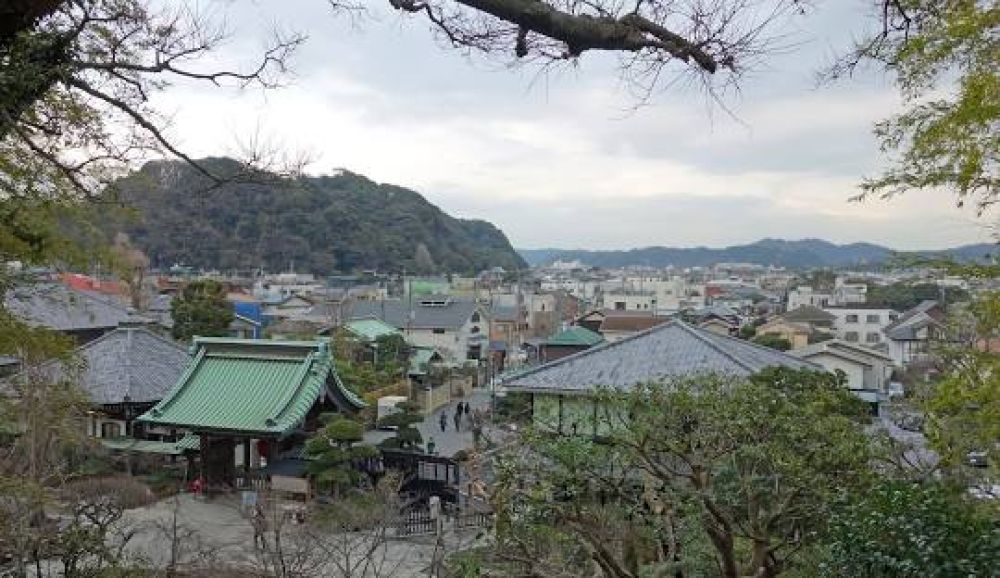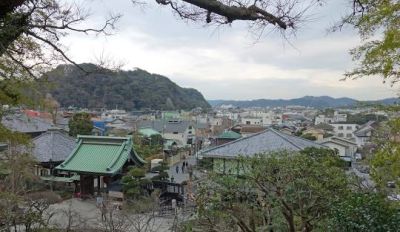

The iconic Great Buddha of Kamakura, also known as Daibutsu, is a monumental outdoor bronze statue of Amida Buddha located at the Kotoku-in Temple in Kamakura, Japan. Standing at an impressive height of approximately 11.4 meters and weighing around 121 tonnes, it is the second-largest monumental Buddha in Japan. The statue has a long history, dating back to 1252, and has withstood various natural disasters, including a tsunami in 1498 which washed away the temple building that once housed it. Today, visitors can admire the statue's serene expression and the intricate details of its curls and robes. The hollow interior of the statue is even accessible to visitors, allowing for a unique perspective of this historical wonder. Exploring the temple grounds and the surrounding garden adds to the serene experience.
For nature lovers and hiking enthusiasts, the Daibutsu Trail offers an exceptional mix of cultural and outdoor experience in Kamakura, Japan. The trail connects Kita-Kamakura with the Great Buddha of Kamakura, passing through lush forests, scenic vistas, and historical temples along the way. The trail is well-maintained and marked, making it suitable for beginner hikers, while still offering enjoyable challenges for more experienced hikers. Along the path, one can discover hidden gems such as the Zeniarai Benzaiten Shrine, where people wash their money with the belief it will double. The hike also passes through the Genjiyama Public Park, which is a great spot for a picnic with views of the city. Bird watching and seasonal flora add to the aesthetic pleasure of the hike.
Tsurugaoka Hachimangu is Kamakura's most important Shinto shrine and is a must-visit for any trip to the city. Established by Minamoto Yoriyoshi in 1063 and moved to its current site by Minamoto Yoritomo, the founder of the Kamakura shogunate, in 1180. The shrine's grounds are expansive, featuring multiple buildings, ponds, and museums. Visitors can stroll through the beautiful peony garden, visit the treasure house, and witness traditional weddings on the weekends. The shrine is picturesque during cherry blossom season and during the autumn when the leaves are changing colors. Climbing the long stairway to the main hall, one will be treated to a panoramic view of the city.
Yuigahama Beach is a popular destination for both tourists and locals, especially during the warm summer months. This sandy beach offers a relaxing getaway with a view of the Sagami Bay. There are plenty of activities to enjoy such as swimming, sunbathing, and surfing. The beach is also lined with small shops and eateries, where visitors can enjoy fresh seafood and other local treats. During the off-season, the beach becomes a peaceful spot for walks and watching the sunset. The laid-back atmosphere, combined with the sound of the waves, provides a contrasting experience to the historic sites of Kamakura.
Engaku-ji is one of the most important Zen Buddhist temple complexes in Japan and is part of the Five Mountain System established by the ruling Hojo regents. Founded in 1282 to commemorate the fallen Japanese and Mongolian soldiers from the attempted Mongol invasions, the temple is set in a wooded area and has numerous sub-temples and a large, inspiring main gate. The Shariden, or Reliquary Hall, purportedly houses one of Buddha's teeth. Visitors can experience Zen meditation sessions (Zazen) held for the public, participate in tea ceremonies, or simply enjoy the tranquility of the temple grounds, which burst into colors of fiery maple leaves in the fall, and delicate cherry blossoms in spring.
Hokoku-ji, often known as the 'Bamboo Temple,' is a small yet visually striking Zen temple in the eastern hills of Kamakura. Famous for its serene and enchanting bamboo garden, the well-preserved grove has over 2,000 Moso bamboo stalks, which create a cool and otherworldly atmosphere. A narrow path winds through the grove leading to a small teahouse where visitors can enjoy matcha green tea while admiring the swaying bamboo. The temple also has a lovely karesansui (rock garden) and a moss garden, along with a few ancient graves. The beauty of this temple is in its subtlety and the feeling of seclusion one gets when walking among the towering bamboo stalks.
Komachi Street is the bustling shopping street that leads from Kamakura Station toward Tsurugaoka Hachimangu Shrine. This lively pedestrian thoroughfare is full of small boutiques, cafes, and restaurants. It's a great place to find souvenirs, such as traditional Japanese sweets (Wagashi), local crafts, and Kamakura-engraved items. For those interested in Japanese cuisine, there are numerous eateries serving everything from sushi and ramen to street food like dango (Japanese dumplings) and soft-serve ice cream in unique flavors like matcha and sweet potato. Komachi Street is not just a shopping destination; it is a cultural immersion into the tastes, sounds, and vibrancy of Kamakura's daily life.
Experience a piece of Japanese maritime tradition by taking a ride on a 'Hangiri', a type of flat-bottomed wooden boat, in the waters of Kamakura. These traditional boats were originally used for seaweed fishing but have become an attraction for visitors looking to enjoy the coastline from a different perspective. A guided tour will take you along the scenic coast while you learn about the history of the area and the role these boats played in the livelihood of the locals. The peaceful journey offers breathtaking views of the lush hills, the majestic Mt. Fuji on clear days, and a look at the iconic Great Buddha of Kamakura from a unique seaside angle.
Hasedera Temple is a beautiful temple complex known for housing a massive wooden statue of Kannon, the goddess of mercy. It is set on a hillside with splendid views over the town and the ocean. The temple is particularly famous for its seasonal flowers; hydrangeas bloom in the rainy season, turning the grounds into a dazzle of blue, pink, and purple hues. Visitors can stroll the grounds which include a pond, a garden, and a cave filled with small Buddhist figures. Take a moment to sit on the observation platform and soak in the relaxing atmosphere and the stunning panoramic views. Hasedera provides a harmonious blend of spirituality, nature, and artistry, making it a soul-soothing must-visit location in Kamakura.
The Zeniarai Benzaiten Ugafuku Shrine, hidden away in a hollow between hills, is one of Kamakura's most mysterious sites. As the legend goes, a divine message instructed the shogunate founder, Minamoto Yoritomo, to build the shrine to bring peace to the country. The waters of the shrine are believed to have the power to multiply the money washed in them – a custom that many visitors still partake in. This Shinto shrine is dedicated to Benzaiten, a goddess of wealth, music, and eloquence. Visitors are struck by the spiritual ambiance as they pass through rock-hewn tunnels to reach the shrine. This unique, tucked-away spot combines the beauty of nature with the charm of legend, making it an intriguing stop on any Kamakura itinerary.
